We may not have the course you’re looking for. If you enquire or give us a call on +44 1344 203 999 and speak to our training experts, we may still be able to help with your training requirements.
We ensure quality, budget-alignment, and timely delivery by our expert instructors.
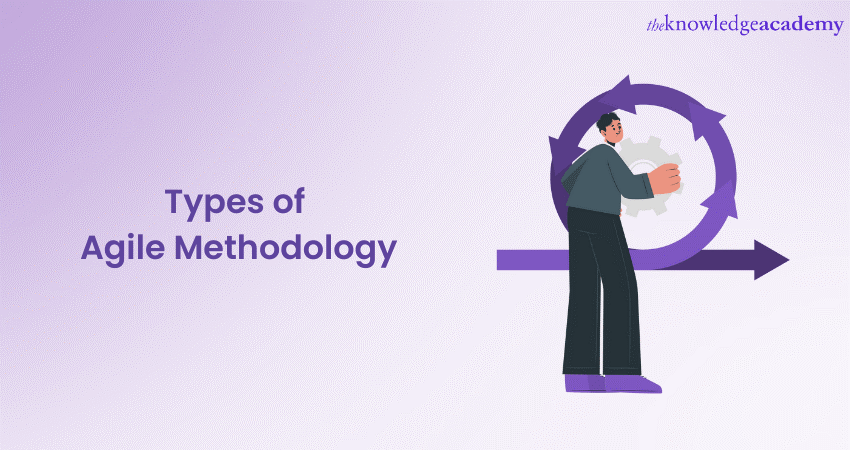
Navigating the intricate landscape of Project Management, a deep understanding of the types of Agile methodology emerges as a cornerstone for organisations aiming for adaptability and heightened customer satisfaction. Agile methodologies, celebrated for their flexibility and responsiveness, have redefined how projects are delivered, ensuring that the end product evolves through a collaborative effort and aligns seamlessly with client needs.
This blog aims to demystify the various Types of Agile methodologies, offering an in-depth exploration to their unique principles, applications, and the distinctive value they bring to the table. By dissecting what are the different types of Agile methodology, we provide a roadmap for organisations to tailor their Project Management strategies effectively. The goal is to ensure a harmonious balance between adaptability, efficiency, and customer-centricity, ultimately leading to successful project outcomes.
Table of Contents
1) Scrum
2) Kanban
3) Extreme Programming (XP)
4) Lean Software Development
5) Feature-Driven Development
6) Dynamic Systems Development Method (DSDM)
7) Crystal
8) Adaptive Software Development (ASD)
9) Rapid Application Development (RAD)
10) Scaled Agile Framework (SAFe)
11) Large-Scale Scrum (LeSS)
12) Conclusion
Scrum
Scrum stands as a frontrunner among the different types of Agile methodology, widely acclaimed for its structured yet adaptable framework. Renowned for fostering collaboration, Scrum subdivides projects into small, manageable units known as Sprints, usually lasting two weeks. Each Sprint aims to build the most valuable features first and deliver a potentially shippable product increment.
Scrum Roles:
1) Product Owner: Defines product features, prioritises work, and communicates the client's vision to the team.
2) Scrum Master: Facilitates Scrum processes, removes impediments, and supports the team in meeting their objectives.
3) Development Team: A cross-functional group responsible for delivering high-quality work.
Scrum Ceremonies:
1) Sprint Planning: Define the work for the upcoming Sprint.
2) Daily Stand-up: A brief meeting to discuss progress and obstacles.
3) Sprint Review: Demonstrate the work completed during the Sprint.
4) Sprint Retrospective: Reflect on the past Sprint and identify areas for improvement.
Scrum's iterative approach and emphasis on continuous improvement create a dynamic environment where change is welcomed and feedback is integral. This methodology is particularly beneficial for projects with undefined or rapidly changing requirements, as it allows for adaptability and quick adjustments to meet the client’s evolving needs. By promoting communication and reflection, Scrum aids teams in staying aligned with project goals and continuously enhancing their workflow.
Kanban
Kanban, originating from Japanese manufacturing, is another versatile type of Agile methodology, especially favoured for its focus on visualising the entire workflow. This methodology is characterised by a Kanban board, a tool used to visualise work, identify bottlenecks, and manage workflow. Unlike Scrum, Kanban does not work in iterations but instead focuses on continuous delivery and minimises the time cycle of work.
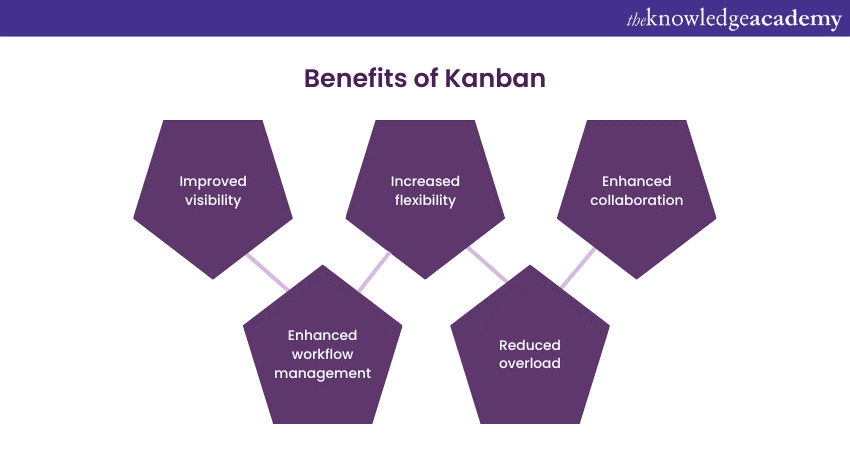
Kanban Principles:
1) Visualise Work: Seeing work in progress helps identify bottlenecks and inefficiencies.
2) Limit Work in Progress: Restricting the amount of work reduces multitasking and ensures quality.
3) Manage Flow: Regularly review, adapt and improve the workflow to reduce cycle times and increase output.
4) Make Policies Explicit: Clear guidelines ensure the process is understood and followed.
5) Feedback Loops: Regular meetings help adapt and improve the process.
Kanban's ability to adapt to changing priorities makes it an excellent choice for operations where work requirements are unpredictable and can change swiftly. It’s particularly beneficial for ongoing maintenance and support tasks, offering flexibility and adaptability to the teams. By allowing teams to visualise their work and adjust according to capacity, Kanban fosters a balanced and efficient work environment.
Elevate your interview game with our curated list of Agile interview questions. Get started now!
Extreme Programming (XP)
Extreme Programming (XP) is a software development methodology that is a part of the Agile framework, focusing intensely on enhancing software quality and responsiveness to changing customer requirements. This methodology advocates frequent releases in short development cycles, which improves productivity and introduces checkpoints where new customer requirements can be adopted.
XP Principles:
1) Communication: Encourages constant communication between team members and customers.
2) Simplicity: Focuses on designing the simplest solution and code.
3) Feedback: Regular feedback from the end user is crucial, as is adjusting the solution when necessary.
4) Courage: Teams are encouraged to question decisions and suggest changes.
5) Respect: Every team member’s input is valued and considered.
XP Practices:
1) Pair Programming: Developers work in pairs, checking each other’s work and providing the support to always do a good job.
2) Test-Driven Development: Writing tests before the code, ensuring every line of code is tested.
3) Continuous Integration: Merging all developed work to a shared mainline several times a day.
XP’s concentration on customer satisfaction and high-quality software development makes it an attractive choice for projects where the client’s involvement is high, and the product requirements may change. By employing rigorous testing and promoting seamless communication, XP ensures that the end product is of the highest quality and truly meets the customer’s needs.
Download the Kanban Rules PDF Guide to understand the core principles of Kanban and how to apply them to improve your team's performance.
Lean Software Development
Lean Software Development, inspired by Lean Manufacturing principles, is a set of principles designed to ensure efficiency by eliminating waste, improving quality, and delivering faster by getting customer feedback quickly. This methodology draws from the notion that the accumulation of waste—anything that doesn’t add value to the customer—should be the primary focus in achieving efficiency.
Principles:
1) Eliminate Waste: Cut out anything that doesn’t add value to the customer or is not necessary.
2) Amplify Learning: The process should facilitate continual learning, which is key to improvement.
3) Decide as Late as Possible: Keep options open as long as practical, but make firm decisions once enough is known.
4) Deliver as Fast as Possible: The quicker the product is delivered without compromising quality, the sooner feedback can be received and incorporated.
5) Empower the Team: The team knows their work best. Giving them ownership enhances their productivity.
6) Build Integrity In: Don’t add integrity later–build it in as the product is developed.
7) Optimise the Whole: Focus on the entire value stream, not just individual components.
Lean Software Development is particularly beneficial for businesses looking to maximise value and minimise waste, ensuring that every aspect of the development process is streamlined and adds value. By focusing on these principles, teams can deliver higher-quality products in shorter timeframes, thereby increasing customer satisfaction and business value.
Enhance your understanding of Agile Portfolio Management with our Lean Portfolio Management SAFe® Training.
Feature-Driven Development
Feature-Driven Development (FDD) is another distinctive Agile methodology, placing a strong emphasis on building and delivering tangible, client-valued features in a systematic, yet flexible manner. In FDD, the overall system is broken down into well-defined, meaningful features, each providing a small piece of client business functionality. Each feature is built and completed before moving on to the next, which ensures a meticulous focus on the development of each functionality.
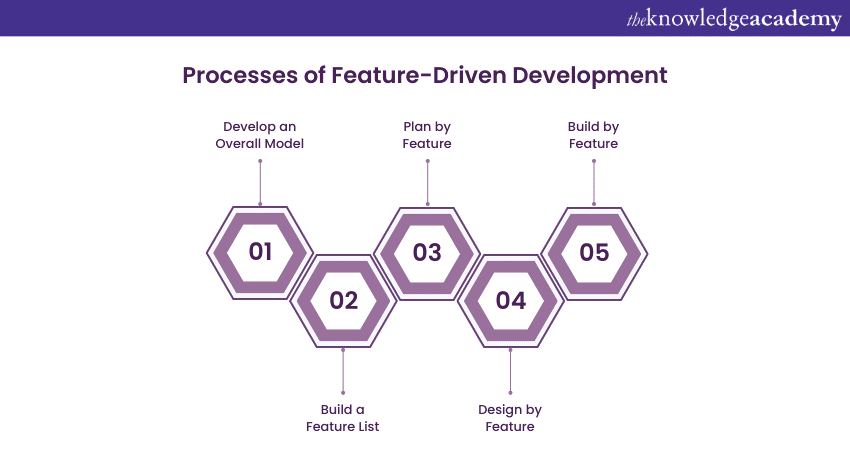
Processes:
1) Develop an overall model: Initial phase where high-level scope and domain model are developed.
2) Build a Feature list: All the features required by the system are listed and prioritised.
3) Plan by Feature: Feature list is used to plan the tasks and assignments.
4) Design by Feature: Each feature is designed in detail.
5) Build by Feature: Each feature is built and integrated into the overall system.
Advantages:
1) Client-centric: Direct focus on client-valued features.
2) Progress visibility: The progress of individual features can be tracked easily.
3) Scalability: Adaptable to projects of varying sizes and complexities.
FDD stands out for its systematic approach to developing client-centric features, ensuring each feature is given undivided attention and developed to its fullest potential. This methodology is particularly advantageous for large-scale software development projects, where breaking down the system into manageable components highlights the advantages of Agile feature-based tasks aids in organising and monitoring progress.
Dynamic Systems Development Method (DSDM)
The Dynamic Systems Development Method (DSDM) is an Agile methodology emphasising the tight schedule and fixed budget aspect of projects. DSDM is structured yet adaptable, allowing adjustments to the project as it evolves, but always within set constraints. It's particularly known for its versatility in integration, allowing amalgamation with other Agile methodologies for a more comprehensive approach.
Principles:
1) Focus on the business need: Every decision should prioritise business objectives.
2) Deliver on time: Time constraints are strictly adhered to.
3) Collaborate: Active user involvement and teamwork are essential.
4) Never compromise quality: Set the quality bar and stick to it.
5) Build incrementally: Develop the system progressively from firm foundations.
6) Develop iteratively: Embrace adjustments as the project progresses.
7) Communicate continuously and clearly: Encourage clear and continuous communication.
Phases:
1) Feasibility and business study: Assessing the project’s viability and initial business study.
2) Functional model / prototype iteration: Developing the functional model and iterative prototyping.
3) Design and build iteration: Iterative design, build and testing.
4) Implementation: Deployment of the solution.
DSDM's approach is advantageous when time constraints are critical, and the project scope and requirements are expected to change dynamically. This methodology ensures quality and timely delivery while accommodating the inherent unpredictability of project development.
Crystal
Crystal, unlike other methodologies, isn’t a single methodology but a family of Agile methodologies, each tailored to different team sizes and project priorities. This unique approach to Agile methodology places people and interactions at its core, emphasising the importance of team communication, individual skills, and talents, thereby adapting to the unique requirements and characteristics of each project.
Principles:
1) Frequent delivery: Delivering working software regularly to receive timely feedback.
2) Reflective improvement: Regularly reflect on and improve team processes.
3) Osmotic communication: Information is easily and freely shared within the team.
4) Personal safety: Ensuring team members feel safe to express their thoughts and opinions.
5) Focus: Concentrating on what’s immediately important and relevant.
6) Easy access to expert users: Having end-users available for constant consultation and feedback.
Characteristics:
1) Adaptability: The methodology adapts to the specific needs of the project and team.
2) Low ceremony: Minimal paperwork and administrative overhead.
3) Team involvement: High emphasis on team member interaction and contribution.
Crystal’s focus on adaptability and team interaction makes it an excellent choice for projects where the human aspect is crucial, ensuring that the skills and talents of each individual contribute to the overall success of the project. By tailoring its approach to each unique scenario, Crystal remains flexible and responsive to changing project needs.
Increase your project success with our Agile Project Management Foundation (AgilePM®) Training – Sign up now!
Adaptive Software Development (ASD)
Adaptive Software Development (ASD) emerged as a response to the rapidly changing and complex environment of software development, positioning itself as a methodology that embraces continuous adaptation and learning. It advocates for collaboration and a non-linear approach, recognising that software development is a complex, creative, and inherently unpredictable process.
Phases:
1) Speculate: Involves defining the general project scope and schedule, but with an understanding that these may evolve.
2) Collaborate: This is where the work is carried out with a strong emphasis on team collaboration.
3) Learn: The phase for reflecting on the project’s progress and learning from the outcomes, adjusting the project accordingly.
Principles:
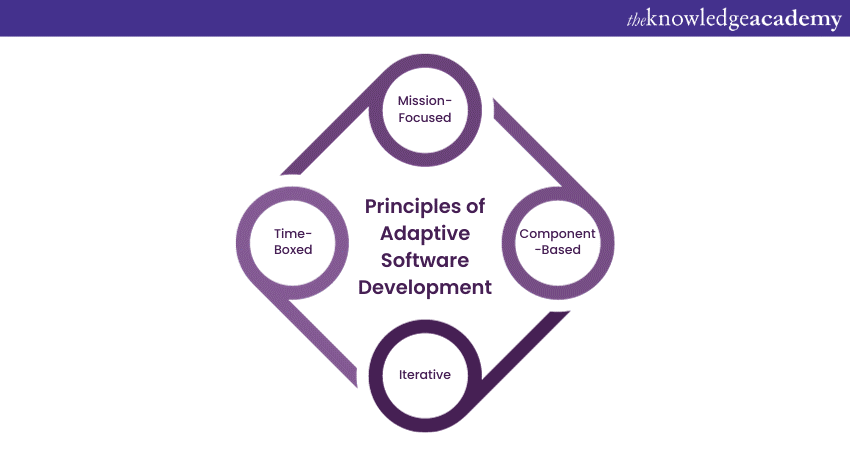
1) Mission-focused: Everyone understands the mission and works towards it.
2) Component-based: The system is divided into components, which can be developed concurrently.
3) Iterative: Regular iterations allow for adaptation and refinement.
4) Time-boxed: Set periods for work and review maintain progress.
By fostering a culture of learning and adaptability, ASD empowers teams to adjust and evolve according to the project’s needs. This methodology is particularly suitable for environments where change is constant, and learning and adaptation are integral to the project’s success. Adaptive Software Development ensures the project stays relevant and aligns with the evolving objectives.
Rapid Application Development (RAD)
Rapid Application Development (RAD) is a type of Agile methodology that prioritises rapid prototyping and quick feedback over long, drawn-out development and testing cycles. The primary objective of RAD is to enable development teams to create and adjust the product in a simultaneous, ongoing manner, thereby offering a quicker and more flexible approach.
Phases:
1) Requirements planning: Define the overall objectives, needs, and constraints of the project.
2) User design: Prototyping, user feedback, and refinement take centre stage.
3) Construction: Building the final product through iterative development.
4) Cutover: Finalising the product, migrating data, testing, and making it ready for launch.
Features:
1) Prototyping: Utilising prototypes to explore solutions, gather feedback, and refine the product.
2) User interaction: Continuous user involvement is key for feedback and refinement.
3) Iterative development: Development is carried out in an iterative manner, allowing for adjustments along the way.
RAD is particularly effective for projects where the requirements are not clear from the beginning and are expected to change, offering a flexible and adaptive development process. Through continuous interactions and feedback, Rapid Application Development ensures that the final product aligns closely with user expectations and requirements.
Scaled Agile Framework (SAFe)
The Scaled Agile Framework (SAFe) is an Agile software development framework designed by Scaled Agile, Inc. It's intended to provide a guide for large organisations to scale Agile and Lean practices beyond single teams. SAFe is particularly beneficial for large-scale projects involving multiple teams and substantial systems, helping to align team objectives and timelines, enhance communication, and optimise workflow.
Discover the key steps in Agile Transformation. Learn more in our insightful blog post!
Levels:
1) Team: Where Agile teams run their processes and deliver value.
2) Program: Aligns teams to a common mission via a Program Backlog.
3) Large solution: For coordinating multiple Agile teams and aligning them to large-scale development.
4) Portfolio: Aligns strategy to execution by applying Lean-Agile principles to the organisation’s strategy.
Principles:
1) Take an economic view: Deliver the most valuable features first.
2) Apply systems thinking: Understand the holistic view of the system.
3) Assume variability; preserve options: Keep options open and adapt as necessary.
4) Build incrementally with fast, integrated learning cycles: Deliver smaller, more manageable pieces and iterate.
SAFe is particularly beneficial for organisations looking to scale Agile principles across the enterprise, providing structure, alignment, and coordination among multiple Agile teams. By focusing on Lean-Agile principles and practices, the Scaled Agile Framework ensures the efficient delivery of large-scale, complex projects.
Want to optimize your agile testing process? Grab the Agile Software Testing PDF today and gain valuable insights into effective agile software testing.
Large-Scale Scrum (LeSS)
Large-Scale Scrum (LeSS) is an extension of Scrum, designed to scale Agile principles to larger organisations and teams while retaining the simplicity and directness of the original Scrum framework. LeSS enables the application of Scrum’s lightweight approach to large-scale, multi-team projects, ensuring adaptability, swift deliveries, and customer satisfaction.
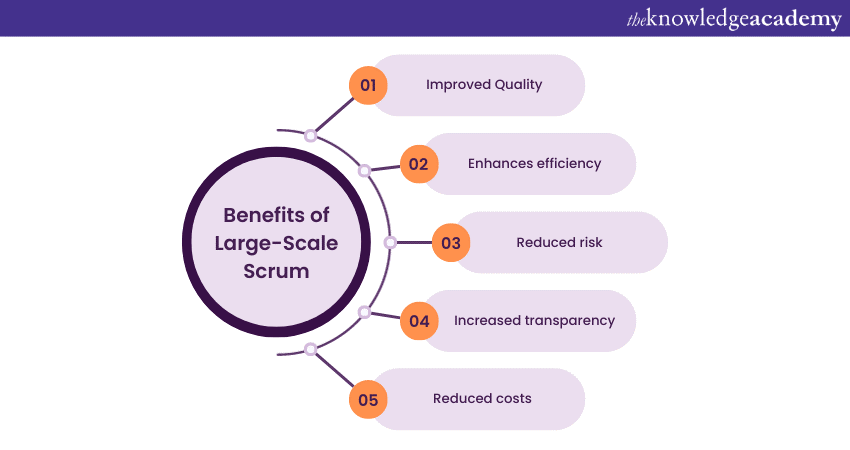
Principles:
1) Whole product focus: LeSS teams work together on one product.
2) Customer-centric: Regular interaction with real customers is crucial for feedback.
3) Continuous Improvement: Regular reflection and adaptation at scale.
Structures:
1) Feature teams: Cross-functional and self-managing teams focused on delivering features.
2) LeSS framework: Framework that includes roles, events, and rules, guiding the LeSS practices.
Adapting the Scrum philosophy to a larger canvas, LeSS helps organisations maintain agility and flexibility at scale. It’s a fitting approach for large enterprises looking to implement Agile without the complexities and intricacies that often accompany scaling.
Conclusion
In summarising the diverse landscape of Agile methodologies, we see each offers unique strategies, from Scrum's iterative cycles to Lean's efficiency focus. Frameworks like Feature-Driven Development provide structure, while methodologies such as Crystal prioritise team dynamics. Meanwhile, Scaled Agile Framework and Large-Scale Scrum cater to larger organisational needs. Ultimately, understanding the various types of Agile methodology enables organisations to choose the best fit for their goals and projects. In today's fast-paced tech environment, the agility and adaptability these methodologies provide are crucial.
Lead the path towards success with our SAFe® Agile Product Management Training – Sign up now!
Frequently Asked Questions
What are the Other Resources and Offers Provided by The Knowledge Academy?

The Knowledge Academy takes global learning to new heights, offering over 3,000 online courses across 490+ locations in 190+ countries. This expansive reach ensures accessibility and convenience for learners worldwide.
Alongside our diverse Online Course Catalogue, encompassing 19 major categories, we go the extra mile by providing a plethora of free educational Online Resources like News updates, Blogs, videos, webinars, and interview questions. Tailoring learning experiences further, professionals can maximise value with customisable Course Bundles of TKA.
Upcoming Project Management Resources Batches & Dates
Date
 Agile Project Management Foundation & Practitioner (AgilePM®)
Agile Project Management Foundation & Practitioner (AgilePM®)
Mon 10th Mar 2025
Mon 12th May 2025
Mon 14th Jul 2025
Mon 15th Sep 2025
Mon 17th Nov 2025






 Top Rated Course
Top Rated Course



 If you wish to make any changes to your course, please
If you wish to make any changes to your course, please


